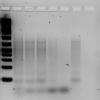is it how total cDNA should look like? - (May/16/2016 )
Hi
No one in my lab has done RT-PCR in ages, so I have a lot of basic questions regarding RNA work.
I've extracted total RNA from the fungal mycelium with TRI reagent. Then I treated RNA with DNAse and used it for a first strand synthesis with random/oligoDT primers (Agilent AffinityScript QPCR cDNA Synthesis kit).
PCR cycle was:
5min @ 25C
5min @ 42C
30min @ 55C
5min @ 95C
Afterwards I run a gel - lanes 2-6 are RT reactions with different amounts of RNA (0.6ug/0.3ug/0.1ug) and different combinations of primers (random/oligoDT/random+oligo). Lane 7 is no RT control.
I have no idea how total cDNA should look like but my samples look essentially like no RT control which probably means that something went wrong.
Does anyone have any suggestions/advices?

So first, it's unusual to run cDNA on gel at all, since it doesn't tell you anything. RT-PCR is pretty robust thing and the bottleneck is RNA quality.
So, after isolation (and DNase digestion), RNA is usually run on gel, to see it's quality. For a highly sensitive applications and generaly better assesment of RNA integrity, Agilent Bioanalyser is used, but that is pricey, though for a serious qPCR it is preferred.
Total RNA on gel (in denaturing conditions, but in our setting it denatured even without the addition of formamide priot to loading, just by heat), should give two distinct bands of rRNA, their ratio is used to tell the quality (example here, but googling "RNA on gel/cheking RNA quality" will give you many hits). The RNA inbetween, that actually interests you is not visible and causes a smear, but generally if the higher band is weak or absent, it means overal degradation. It's just an indirect method.
DNA contamination in RNA is shown as bright stuff stucked in the wells or very high on the gel. Which you don't seem to have in your line 7, not sure about the bands in the other lanes, but that can be anything.
I'm not sure what to take from your picture, the only "RNA" there is lane 7, but that gone through some rough process already, the rRNA bands are visible but faint, if you try proper RNA denaturing gel electrophoresis it may be better (many protocols, generally making just denaturing buffer is enough, surely even more simplier protocols exist, even on this forum if you search), so you can asess the quality of your RNA.
RT-PCT essentially just makes a RNA-DNA hybrid of the original RNA single strand. So, you won't see difference on the gel (maybe the primer dimers, which you have on the bottom) depending on the dye you use for gel (EtBr seems to bind even RNA pretty fine, not sure about RNA-DNA duplexes, if you use other dyes check how they do with RNA alone, but most should work), it may look just uglier. This is really the reason, why no one puts cDNA on gels. From your picture you can't tell exactly if the RNA was bad or not.
You can put your untreated and treated RNA on same gel to see how DNA is digested and how DNase treatment can also damage RNA a bit, it's a nice start to work with RNA.
This is a prep for a qPCR so go on and test it on some reference gene if you know what Ct to expect, to check how good this cDNA is. There is no other way.
Thanks a lot for your reply!
This is a normal gel, maybe that's why RNA is so degraded. I run a bleached gel for the RNA samples after the extraction and it looked fine - for the cDNA I thought it was not necessary. I guess one thing to do is to check RNA quality after DNAse treatment and then just assume that RT reaction was efficient.
In case of DNA-RNA duplex, I'm not exactly sure how the dye is binding that. In theory intercalators should not bind RNA, (especially denatured) but they do.
Efficiency of RT-PCR can be only tested functionally AFAIK, how well it perform. In classic PCR, we did check the cDNA on actin to prove it is OK, and can be used for amplification. Depending on the brightness of actin band we could roughly guess how much usable cDNA there is.
